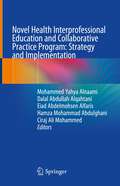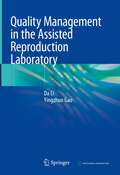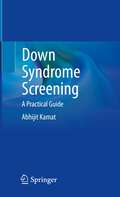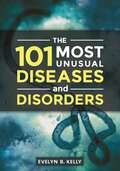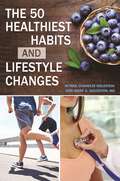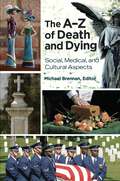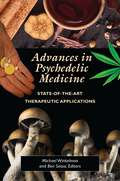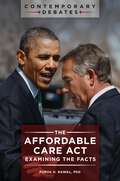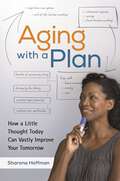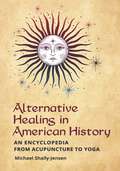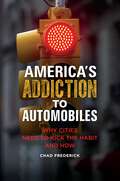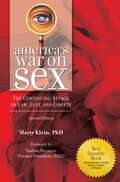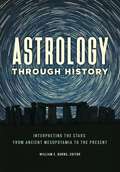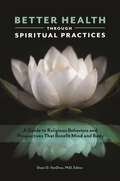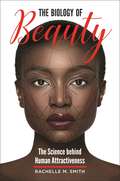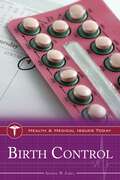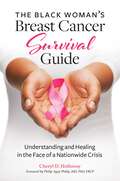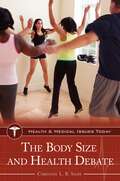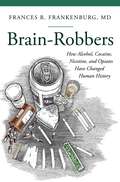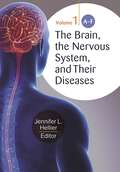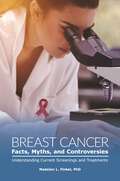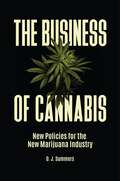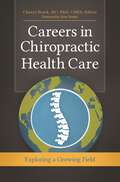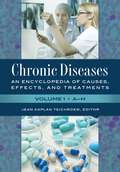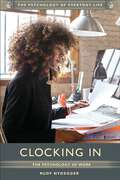- Table View
- List View
Novel Health Interprofessional Education and Collaborative Practice Program: Strategy and Implementation
by Mohammed Yahya Alnaami Dalal Abdullah Alqahtani Eiad Abdelmohsen Alfaris Hamza Mohammad Abdulghani Ciraj Ali MohammedThis book describes a novel health interprofessional education and collaborative practice (IPECP) program established at King Saud University (KSU), Riyadh, Kingdom of Saudi Arabia. The book has three main sections. The first section introduces interprofessional education's background, theory, and context for collaborative practice. This section elaborates on defining and developing centers of excellence in IPECP, defining and exploring the meaning of interprofessional collaborative practice in contemporary health care, theories of the team working relevant to health and social care systems, and learning in and about interprofessional groups and broader collaboration. The second section explains how to formulate and implement strategies for effective IPECP. It involves developing and implementing a novel health IPECP curriculum, governance, IPECP's impact and implications on health care outcomes, IPE accreditation standards, regulatory policies, and legal structures. The third section describes the result of a case study of an IPECP program established at KSU. This program is developed by the vice-rectorship for health specialties at KSU (VRHS-KSU) in collaboration with partners harvard medical international (PHMI) to enhance health professional education further through interprofessional education and collaboration. For that purpose, a strategic plan is developed to develop learning, teaching, and assessment in all health sciences colleges (HSCs), along with a governance structure to establish a joint "center of excellence in interprofessional education and collaborative practice (CoE-IPECP)". The strategic plan and design of the program summarized in this book were accomplished through several meetings, workshops, and courses conducted at KSU in Riyadh, and harvard macy institute (HMI) in Boston, USA. The toolkit for successful program implementation includes a pro forma business plan, implementation groups' training, matching needs with feasibility, and expected impact on HSCs. Initiation of pilot projects started with implementing some interprofessional courses, establishing an initial physical and IT infrastructure of the center, developing the webpage, newsletter, and listservs, and improving faculty development programs to enhance IPECP at HSCs. Also, this book is a helpful road map for other national and international universities and institutes aiming to develop their professional health education, particularly interprofessional education and collaborative practice.
Quality Management in the Assisted Reproduction Laboratory
by Da Li Yingzhuo GaoThis book provides readers up-to-date information on various aspects affecting assisted reproduction laboratories and corresponding management approaches, based on latest literatures, clinical practice, and international consensus. Key points of laboratory environment, laboratory operations and quality control measures are presented in details. Last but not least, ethical issues and countermeasures of assisted reproductive technology are discussed. It will be a practical and reader-friendly resource to help reproductive medicine practitioners establish a disciplined risk and control system for assisted reproduction laboratories and techniques.
Down Syndrome Screening: A Practical Guide
by Abhijit KamatThe book elucidates a practical method for prenatal screening and detecting Down syndrome in a simple and easy-to-understand language. It provides thorough knowledge on the subject, and each chapter covers a specific topic, making this book an essential quick-reference guide for every antenatal clinic. The book contains chapters on maternal serum screening, noninvasive prenatal testing (NIPT), invasive testing with amniocentesis and CVS, and screening in twins. It also includes advanced chapters on multi-step screening protocols, uncommon aneuploidies, screening for preeclampsia, and open neural tube defects for clinicians interested in fetal medicine. Down syndrome is the most typical genetic condition affecting over 5 million individuals globally. Rapid advances in the medical field make it possible to identify most of these babies before birth. Hence, aneuploidy screening is now offered to pregnant women worldwide. The book aims to help obstetricians and gynecologists diagnose Down syndrome and other aneuploidies in pregnancy, avoid unnecessary testing, and remain safely within medico-legal boundaries. It is also helpful for fetal medicine students. The book helps the readers address challenging clinical scenarios and confusing test results.
The 101 Most Unusual Diseases and Disorders
by Evelyn B. KellyThis book explores serious diseases and disorders that most readers have never heard of, ranging from genetic, infectious, and environmental diseases to autoimmune, idiopathic, and mental disorders.Despite centuries of scientific study and medical research, there are still many human diseases and disorders that remain difficult to manage or are incurable. Some of these maladies are extremely rare, yet, together, they affect a substantial number of people. The 101 Most Unusual Diseases and Disorders examines seldom-seen illnesses, providing high school and college students with an excellent resource for research as well as supplying fascinating reading for general readers interested in diseases and medical science.This book provides clear, easy-to-understand, and scientifically grounded information on the vast number of unusual medical conditions that have been recorded, covering five kinds of diseases and disorders: genetic, infectious, environmental, mental, and "other," which constitutes diseases of autoimmune and unknown origin. Examples of the medical conditions addressed include autoimmune encephalitis, Ebola, kleptomania, Morgellons syndrome, orthorexia, pneumoconiosis, and Prader-Willi syndrome. Selected case studies enable readers to better empathize with the experiences of those who have these disorders and how these afflictions have affected their lives.
The 50 Healthiest Habits and Lifestyle Changes
by Myrna Chandler Goldstein Mark A. MDThis book summarizes the findings of scientific research studies to provide readers with straightforward information on a wide variety of healthy habits and the factors that may make them difficult to follow.How can taking a yearly vacation serve to improve your health? Is there any scientific proof that skipping breakfast is detrimental to one's health? Americans are constantly bombarded with health tips from magazines, television, the Internet, and other media, but much of this information can be inaccurate. The 50 Healthiest Habits and Lifestyle Changes provides authoritative, research-based information on habits that are important for everyone, but especially teens and young adults.This easy-to-read book highlights 50 habits for promoting physical as well as mental/emotional and social health. Each entry describes a healthy habit, explains the benefits of that habit, and examines the supporting research and statistics. The book also provides information on major barriers and problems related to each habit and discusses how habits are formed and maintained, covering topics such as positive and negative reinforcement, reward loops, and brain chemistry. Each entry has a section of references and resources that enables readers to conduct their own follow-up research.
The A–Z of Death and Dying: Social, Medical, and Cultural Aspects
by Michael BrennanThis engaging and informative resource provides readers with an understanding of the social, cultural, and historical influences that shape our encounters with death, dying, and bereavement—a universal experience across humanity.Written in an engaging and accessible style by leading international scholars and practitioners from within the field of death and bereavement studies, this book will have broad appeal, providing in a single volume insights from some of the key thinkers within the interdisciplinary field of death, dying, and bereavement. Its approximately 200 entries will serve as useful starting points for those new to the topic and will be informative to those already acquainted with some of the core concepts and ideas within this burgeoning field of inquiry. This encyclopedia will serve as an essential resource for high school and undergraduate students, those engaged in independent research, and professionals whose work involves caring for the dead, dying, and bereaved. It will also be of great interest to general readers intrigued by the social, medical, and cultural dimensions to human mortality. Underscored by the inescapable biological certainties that affect us all, The A–Z of Death and Dying offers a highly relevant examination of the social and historical variation in the rituals, practices, and beliefs surrounding the end of life.
Advances in Psychedelic Medicine: State-of-the-Art Therapeutic Applications
by Michael Winkelman and Ben Sessa, EditorsResearchers, program administrators, and practicing clinicians explain the most recent developments in using psychedelic substances to treat psychological, physiological, and social problems.More than a decade ago, the U.S. government lifted its ban on all testing of psychedelic substances. Winkelman and Sessa now provide updated scientific research and applications of these substances, now moving into approved categories of medicine. The text is an up-to-date assessment of the latest advances in the field of psychedelic medicine, covering the use of LSD, psilocybin, MDMA, ayahuasca, and other substances to augment psychotherapies for a range of disorders. It discusses medical and psychiatric concerns, clinical efficacy and safety, ethical considerations, and neuroscience findings regarding the psychedelic compounds. Topics covered include an overview of psychiatric applications of psychedelics; treatments for addictions and depressive disorders; effects of psychedelics on inflammation and neuroplasticity; evidence for clinical applications of DMT, ayahuasca, and cannabidiol; psychedelic treatment of sociopathic disorders; microdosing psychedelics; training psychedelic therapists; and community-based harm reduction approaches to managing psychedelic crises.
The Affordable Care Act: Examining the Facts (Contemporary Debates)
by Purva H. RawalThis is the first reference book to provide a detailed assessment of the Affordable Care Act, explaining the realities and myths surrounding one of the most divisive political struggles in recent U.S. history.The Affordable Care Act—also known as Obamacare—is one of the most controversial and politicized topics in the United States today. This timely book examines prominent claims about the legislation's drafting, debate, passage, and implementation, and discerns what is true and false about the law. Each of the text's eight chapters delves into the common beliefs, misinterpretations, and myths surrounding the act, tracing the history of the assertion and supporting or challenging its veracity through nonpartisan research and analyses.Chapters begin with an objective look at the claim's origins—with a brief focus on the person or group that conceived it and why—then set about clarifying or debunking it using evidence from research studies and reports from authoritative sources. Entries feature primary documents, a further reading section, and tables and graphs. Topics include the impact on health care costs for families, states, and the federal government; the effect of the Affordable Care Act on employer-sponsored insurance; and the role of health status on coverage under the Affordable Care Act.
Aging with a Plan: How a Little Thought Today Can Vastly Improve Your Tomorrow
by Sharona HoffmanThis book offers a concise, comprehensive resource for middle-aged readers who are facing the prospects of their own aging and of caring for elderly relatives—an often overwhelming task for which little in life prepares us.Everyone ages, and nearly everyone will also experience having to support aging relatives. Being prepared is the best way to handle this inevitable life stage. This book addresses a breadth of topics that are relevant to aging and caring for the elderly, analyzing each thoroughly and providing up-to-date, practical advice. It can serve as a concise and comprehensive resource read start-to-finish to plan for an individual's own old age or to anticipate the needs of aging relatives, or as a quick-reference guide on specific issues and topics as relevant to each reader's situation and needs.Using an interdisciplinary approach, Aging with a Plan: How a Little Thought Today Can Vastly Improve Your Tomorrow develops recommendations for building sustainable social, legal, medical, and financial support systems that can promote a good quality of life throughout the aging process. Chapters address critical topics such as retirement savings and expenses, residential settings, legal planning, the elderly and driving, long-term care, and end-of-life decisions. The author combines analysis of recent research on the challenges of aging with engaging anecdotes and personal observations. By following the recommendations in this book, readers in their 40s, 50s, and early 60s will greatly benefit from learning about the issues regarding aging in the 21st century—and from investing some effort in planning for their old age and that of their loved ones.
Alternative Healing in American History: An Encyclopedia from Acupuncture to Yoga
by Michael Shally-JensenThis book examines alternative healing practices in American popular culture. From traditional folk approaches to more recent developments, it discusses the rise and fall of more than 100 popular approaches to addressing both physical ailments and mental health needs.Offering insightful accounts of everything from aging prevention to voodoo & Santería, Alternative Healing in American History: An Encyclopedia from Acupuncture to Yoga situates each popular approach in the history and culture of health and wellness in America. Moreover, the book shows that "orthodox" medicine and unconventional approaches may have more in common than many people think, because both are subject to the changing nature of the medical understanding and the strength of their appeal to consumers. While the main focus is on remedies lying outside the medical mainstream, the book also highlights how many widely accepted therapeutic treatments of the past—for example, "the water cure" (hydrotherapy) or lobotomy (psychosurgery)—fell out of favor and were quickly forgotten. Besides examining popular healing techniques, the book also explores the changing nature of the medical marketplace and how once-standard treatments (e.g., leeching, psychoanalysis) have had their ups and downs. The book comprises five chronological sections covering time periods from pre-1900 to the present.
America's Addiction to Automobiles: Why Cities Need to Kick the Habit and How (Environmental Degradation and Public Health)
by Chad FrederickA provocative look at our nation's dependency on the automobile and how its potential impact on urban design will either make or break our health, economy, and quality of life.In this thought-provoking work, author and urban planning expert Chad Frederick scrutinizes the use of automobiles in cities, investigating its role in exacerbating urban inequalities and thwarting sustainability of modern society. Through a comprehensive, thoughtful discussion, Frederick illustrates how the automobile is fundamentally at odds with the very nature of cities. He shows how cars impose huge burdens on our health, equity, environment, local and national economy, and quality of life. Most of all, he shows how automobile dependency has put our entire society at risk. The book delves into the monumental role of automobiles in the development of cities after the Great Depression, impacting the American identity and affecting the way we produce and manage urban spaces. Frederick provides compelling evidence that cities with more diverse modes of transportation are greener, healthier, more prosperous, and even more enjoyable places to live than automobile-dependent cities. He identifies one institution responsible for our inability to improve our cities: the social sciences, and examines the root cause of our inability to make progress toward more multi-modal cities. In conclusion, the author offers a radical solution for moving beyond the underlying logic that forces us to create automobile-dependent cities.
America's War on Sex: The Continuing Attack on Law, Lust, and Liberty (Sex, Love, and Psychology)
by Marty Klein Ph.D.This book exposes how a coalition of political, religious, and civic leaders are using the issue of sex to frighten, misinform, and bully Americans—paving the way for dramatic new public policies that are already restricting everyone's rights.Americans are more vulnerable today than ever to anxiety about sexual danger, to believing that their sexuality is not "normal" or moral, and to laws and public policies that restrict their rights, criminalize their consenting behavior, and confuse and miseducate their children. In the second edition of America's War on Sex: The Continuing Attack on Law, Lust, and Liberty, psychologist, sex therapist, and courtroom expert witness Marty Klein sets the record straight and uncovers how the "Sexual Disaster Industry" works—a powerful social and political propaganda machine that is supported by the very citizens it victimizes.This book analyzes eight "battlegrounds" in which America's War on Sex is being fought and examines how each one is the focus of an unrelenting struggle to regulate sexuality in direct contradiction to our Constitutional guarantees, scientific fact, and the needs of average Americans. Klein places these various attacks on our rights in historical context, explains how the money and political power are coordinated from the same sources, and shows how the Religious Right inflames Americans' anxiety about sexuality even as it proposes repressive schemes to reduce that anxiety. This book tackles a sensitive and volatile topic head-on, addressing how the political, social, historical, religious, and emotional issues surrounding public policy interfaces with sexuality as no other work has before.
Astrology through History: Interpreting the Stars from Ancient Mesopotamia to the Present
by William E. BurnsAlphabetically arranged entries cover the history of astrology from ancient Mesopotamia to the 21st century. In addition to surveying the Western tradition, the book explores Islamic, Indian, East Asian, and Mesoamerican astrology.The field of astrology is growing rapidly, as historians recognize its centrality to the intellectual life of the past and sociologists and anthropologists treat its importance in a number of modern cultures. Despite the historical and cultural significance of the subject, most reference works on astrology focus on instructional techniques and are written by astrologers with little or no interest in the history of the topic. This book instead offers an objective treatment of astrology across world history from ancient Mesopotamia to the present.The book provides alphabetically arranged entries by expert contributors writing on such topics as horoscopes, court astrologers, Renaissance astrology, and comets. While it considers the Western tradition, it also treats Islamic, Indian, East Asian, and Mesoamerican astrology. In doing so, it explores the role of astrology in shaping science, literature, religion, art, and other defining cultural traditions. Sidebars offer excerpts from various historical texts, while entries provide suggestions for further reading.
Better Health through Spiritual Practices: A Guide to Religious Behaviors and Perspectives That Benefit Mind and Body (Race, Ethnicity, Culture, and Health)
by Dean D. VonDras, PhD, EditorAn in-depth examination of religious practices around the world and the fascinating science behind how they make us healthier.Many religious and spiritual beliefs promote wellness through their practices or stated objectives—for example, focusing on simple living, having compassion for others, vegetarianism, or meditation and mindfulness. This refreshing work provides a review of the world's spiritual perspectives and traditions, and explores how their guiding principles encourage healthy lifestyle choices. An examination of religious and nonreligious perspectives from around the world—from atheism, Confucianism, and Christianity to Islam, Judaism, Shamanism, and Zoroastrianism—reveals how faith beliefs and values influence behavior and inspire healthy living.With contributions from leading international scholars, the chapters include a discussion of Eastern and Western world religions and their practices—such as fasting or the avoidance of alcohol and tobacco—and how they may foster healthfulness. A contemporary analysis of current research findings suggests possible interventions that individuals and health providers may utilize to enhance healthfulness. A final chapter explores the connection between health, illness, and religious and nonreligious perspectives.
The Biology of Beauty: The Science behind Human Attractiveness
by Rachelle M. SmithThis thought-provoking book examines the science behind human attractiveness—the ratios, proportions, and other factors that to a large extent dictate what we find "beautiful."It's said that "beauty is in the eye of the beholder," but recent scientific research suggests that human attractiveness is much more objective than we once thought, deeply rooted in our biology and evolutionary history. For instance, facial symmetry is considered extremely attractive because it indicates good health and nutrition during the formative developmental years. This book explores these insights.Part I of The Biology of Beauty: The Science behind Human Attractiveness takes a closer look at what traits we find the most alluring and why. It discusses why attractiveness is important from an evolutionary standpoint and the advantages (and disadvantages) of being attractive. In addition to exploring these beauty "universals," it examines how beauty ideals can be shaped by factors such as culture, religion, and the media. Part II provides an in-depth analysis of individual features that contribute to attractiveness, offering scientific explanations for our preferences. The book also includes a collection of insightful sidebars that highlight beauty ideals in different parts of the world and at other times in history.
Birth Control (Health and Medical Issues Today)
by Aharon W. ZoreaIntended as a reference tool for college students, this book examines the origins of and controversies associated with birth control in the United States.Issues regarding access to, education about, and practice of birth control have played a pivotal role in religious, social, and political conflicts throughout the 19th and 20th centuries. In the 21st century, controversies surrounding birth control remain at the forefront of current political debates over topics as varied as women's rights, social welfare initiatives, federal healthcare funding, consumer protection and physician liability, and informed consent. Birth Control provides a historical background of premodern practices, describes birth control in the 19th–20th centuries, and discusses all currently available types of contraceptive systems, including both artificial and natural methods. The treatment of contemporary public debates on birth control addresses questions posed on practical, ethical, religious, and moral grounds, presented respectfully and in a balanced fashion.
The Black Woman's Breast Cancer Survival Guide: Understanding and Healing in the Face of a Nationwide Crisis
by Cheryl D. HollowayBreast cancer is reaching epidemic levels, especially among black women. This survival guide provides tools that women—black women in particular—can use to identify and combat this all-too-common threat.This "what you need to know" guide is unique in its common sense, "laywoman's" approach and particular relevance to women of color. Its premise is simple: ignorance and lack of education about breast cancer signs and symptoms are still all too prevalent among black women. Many women are not informed about resources available for early detection screening and are not referred for mammography screening. They may also receive significantly delayed treatment—especially black women. For those reasons and more, black women with or at risk for breast cancer need an advocate who speaks for them and tells them the truth. They have that advocate in Cheryl Holloway, PhD—and in this book. A breast cancer survivor and cancer researcher, Dr. Holloway draws on her personal experience and research to offer something far different than the usual medical/oncological works. Her book provides support, current information, and practical advice for confronting and beating the disease. The book is divided into four parts. "Dealing with the Basics" explains how breast cancer hits black women harder and discusses the types of breast cancer they may develop, with an emphasis on the most dangerous. The second section offers practical information, such as how screenings work and the meaning of various breast cancer tests. Part three describes treatments, including surgery, radiation therapy, chemotherapy, hormone therapy, combined therapy, and other options. The final section describes how to stay vigilant after the cancer is gone and also discusses other forms of cancer for which black women are at risk, such as lung cancer, colon cancer, and cervical cancer.
The Body Size and Health Debate (Health and Medical Issues Today)
by Christine L. SelbyHas the connection between body size and overall health been overstated for decades? This book examines how our dogged efforts to eradicate obesity may be doing more harm than good and explores alternative ways to measure and encourage health.It's fair to say that Americans are obsessed with body size and weight—whether it's in the name of health and disease prevention or the idealization of unrealistically thin proportions. But trying to lose weight and drop clothing sizes is healthy, right? Or is it not healthy, in many cases?In this book, the latest in Greenwood's Health and Medical Issues Today series, Certified Eating Disorder Specialist and Certified Sport Psychology Consultant Christine L. B. Selby, PhD, examines the often confusing information—and misinformation—that exists on obesity and its connection to overall health. She provides a broad examination of this timely topic, addressing the rate of obesity in the United States, questioning the appropriateness of BMI to gauge overall health and well-being, discussing controversies related to weight and health including excessive dieting, and providing real-world scenarios that clearly illustrate major concepts related to weight and health. The book also summarizes a relatively new and still controversial approach to improving well-being that takes the focus off the number on the scale. But can individuals really be happy and healthy at any size
Brain-Robbers: How Alcohol, Cocaine, Nicotine, and Opiates Have Changed Human History
by Frances R. MDA psychiatrist examines how the world's four most important mind-altering substances— alcohol, cocaine, nicotine, and opiates—have played a significant role throughout human history, and explains how these powerful drugs affect the brain and cause addiction.Alcohol, cocaine, nicotine, and opiates have spurred some of the greatest human pleasure and pain across time. Providing information that ranges as widely as from ancient Egypt to modern times, this book comprehensively addresses the good, the bad, and the very ugliest aspects of these substances, examining their history, their effects on the brain and body, and on civilization itself. Frances R. Frankenburg, MD, employs accessible, everyday language to explain the neurology of addiction and describe how these "brain-robbing" substances work to hijack the brain's pleasure systems to create powerful addictions. The author also provides perspective into the intertwined, inescapable, and often uneasy relationship between these substances and human culture, economics, and politics—for example, how individuals become physically or psychologically addicted to alcohol, cocaine, nicotine, and opiates, while governments become financially "addicted" to the revenue, such as taxes, that can be collected from the sale and use of these substances.
The Brain, the Nervous System, and Their Diseases [3 volumes]: [3 volumes]
by Jennifer L. HellierThis comprehensive encyclopedia provides a thorough overview of the human brain and nervous system—the body's "CPU and data network." It covers basic anatomy and function, diseases and disorders, treatment options, wellness concepts, and key individuals in the fields of neurology and neuroscience.Written to be accessible to high school and college students and general readers, this three-volume encyclopedia provides a sweeping overview of the brain, nervous system, and their diseases. Bringing together contributions from leading neuroscientists, neurologists, family physicians, psychologists, and public health professionals, the work covers both brain anatomy and function and neurological disorders, addressing how underlying processes—whether biological, developmental, environmental, or neurodegenerative—manifest themselves.Roughly a third of the entries are about neuroscience and how neurons "talk" to each other in brain circuits to provide normal function. Another group of entries discusses abnormalities or dysfunctions of the brain that develop into disorders or diseases, while a third group focuses on research and experimental procedures commonly used to study the nervous system. The encyclopedia also explores its subject from a wellness perspective, explaining actions that can prevent neurological disorders and injuries and promote general nervous system health. By addressing both ends of the spectrum, the work presents a holistic perspective that will appeal to a broad range of readers.
Breast Cancer Facts, Myths, and Controversies: Understanding Current Screenings and Treatments (Public Health Issues and Developments)
by Madelon L. FinkelThis book, written for the layperson, provides evidence-based material explaining the complex and evolving evidence of the benefits and limitations of breast cancer screening and the advances in breast cancer treatment.A diagnosis of breast cancer is one of the most emotionally charged statements a woman can hear from her doctor. Understanding the rapid changes in breast cancer diagnosis and treatment is challenging, especially for those without a medical background. This book will help explain the strengths and weaknesses of breast cancer screening, breast cancer treatment, and ways of coping with the disease (for oneself or a loved one).Written for the layperson, this text explains the history of disease prevention with a specific emphasis on breast cancer detection and treatment. The main chapters weigh the pros and cons of well-known but often mystifying screening tests, such as mammograms; discuss the benefits and side effects of targeted hormone therapies; consider holistic regimens that complement traditional medicine; and explore the mental, physical, and emotional strain caused by breast cancer. Concluding with the current breast cancer screening guidelines recommended by leading organizations in disease prevention, Breast Cancer Facts, Myths, and Controversies not only engages with the history of breast cancer screening, diagnosis, and treatment, it looks ahead to a brighter future for survivors.
The Business of Cannabis: New Policies for the New Marijuana Industry
by D. J. SummersWhat happens when corporate culture takes over counterculture? This book explores the contradictions present within the cannabis industry from a business and policy perspective.Despite the unique culture surrounding cannabis, this new industry follows the same economic principles as does any other agricultural product—that is, it would if the federal government allowed it to. Four distinct challenges prevent the cannabis industry from becoming fully legal and federally regulated in the United States, equivalent to the alcohol, pharmaceutical, or tobacco industries: federal regulations counter to state laws, an unfriendly financial system, a U.S. attorney general bent on keeping the drug war running, and Prohibition's 70-year-old legacy of distrust between legalization advocates and opponents. Policy, however, is changing. Already the world's most heavily consumed illicit drug is in the midst of an international transformation. Globally, a new international trade market has emerged from efforts to legalize it for medical or recreational use, and in the United States, the nascent cannabis industry has acquired lobbyists, well-financed industry kingpins, an extensive ancillary industry, and taxation. The Business of Cannabis explores these issues in depth and contextualizes U.S. drug policy at a time when lawmakers across the nation are deciding which way to lean on the issue.
Careers in Chiropractic Health Care: Exploring a Growing Field
by Cheryl Hawk and John WeeksThis book provides potential students of a chiropractic career path, as well as other health care practitioners, with vital information regarding the training required to enter the chiropractic field and the roles of chiropractors in modern health care.Chiropractic is the second largest physician-level health profession in the United States, with chiropractors providing care to at least 20 million patients annually. As chiropractic health care has been proven to be both effective and cost effective for many musculoskeletal conditions, particularly back pain, the inclusion of Doctors of Chiropractic (DCs) in a variety of health care settings is likely to continue to increase. Surprisingly, there is little readily accessible information on chiropractic as a career path. This book provides concise yet comprehensive information about career paths, training, and professional roles in chiropractic for students considering chiropractic as well as health care practitioners in the field.Written in an easy-to-read style, Careers in Chiropractic Health Care: Exploring a Growing Field serves students, those in non-chiropractic health fields, and general readers considering chiropractic as a career change option. The chapters explain the training and specific licensure requirements for chiropractors in all 50 U.S. states and provide information useful to health care professionals for referrals and management of patients using chiropractic care.
Chronic Diseases [2 volumes]: An Encyclopedia of Causes, Effects, and Treatments [2 volumes]
by Jean Kaplan Teichroew, EditorThis comprehensive two-volume work provides an overview of an area of growing concern, offering readers a one-stop resource for researching the chronic conditions that increasingly plague our society.Chronic diseases and their consequences are among the foremost problems faced by the U.S. health care system, accounting for untold distress and mounting personal and societal costs. Bringing together an unprecedented array of detailed data and facts, this unique two-volume encyclopedia provides information that will help readers understand what they can do to avoid these diseases, as well as how to best manage chronic conditions that may affect them or their families.Designed for high school, public, and university libraries, this three-volume set covers an extensive range of disorders, including diabetes, cancer, high blood pressure, asthma, heart disease, arthritis, osteoporosis, kidney disease, Alzheimer's disease, HIV/AIDS, and hepatitis. Depression and anxiety are covered, as are violence and injury, drug use and abuse, and tobacco as a health hazard. Much more than just a list of diseases, this encyclopedia enables readers to easily research terminology, symptoms, methods of diagnosis, medical treatments and alternative medicine, risk factors, associated conditions, and preventive approaches. The work is consistent with Healthy People 2010 national goals and objectives and with National Health Education Standards.
Clocking In: The Psychology of Work (The Psychology of Everyday Life)
by Rudy NydeggerCovering important topics such as job satisfaction, workplace stress, and the changing nature of jobs and careers in the 21st century, this valuable resource explores how working affects us psychologically, for better and for worse and sometimes in imperceptible ways.Although most people go to work Monday through Friday, few stop to think about the central role work plays in our lives. Besides allowing us to provide for the material needs of ourselves and our families, having a job or career can help us to meet new people and stay socially connected, to increase our self-esteem and sense of self-worth, and to allow us to have an impact on the world. But work can also leave us exhausted and stressed, and many people find it difficult to balance their work and personal lives.This clear and accessibly written book in Greenwood's Psychology of Everyday Life series provides readers with an understanding of the important roles work plays in our lives, the many forms work may take, and the ways in which our relationships with work change throughout our lives. The information, presented in an unassuming, easy-to-understand manner, is drawn from classical theory as well as from contemporary research, affording readers a well-rounded understanding of the topic. The book also includes a collection of real-world scenarios to illustrate key concepts as well as scholarly essays offering perspective on current issues and debates related to work in America.
